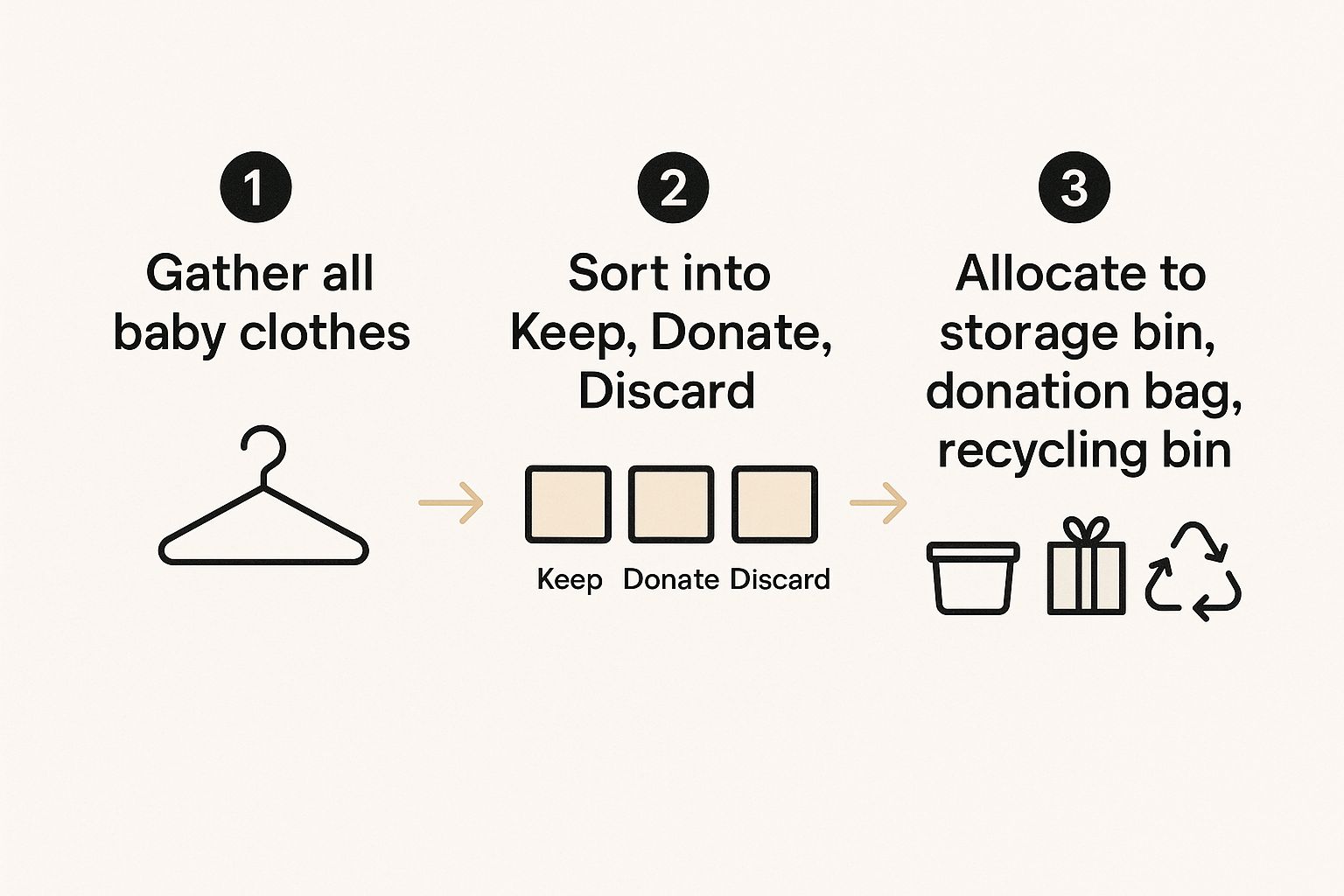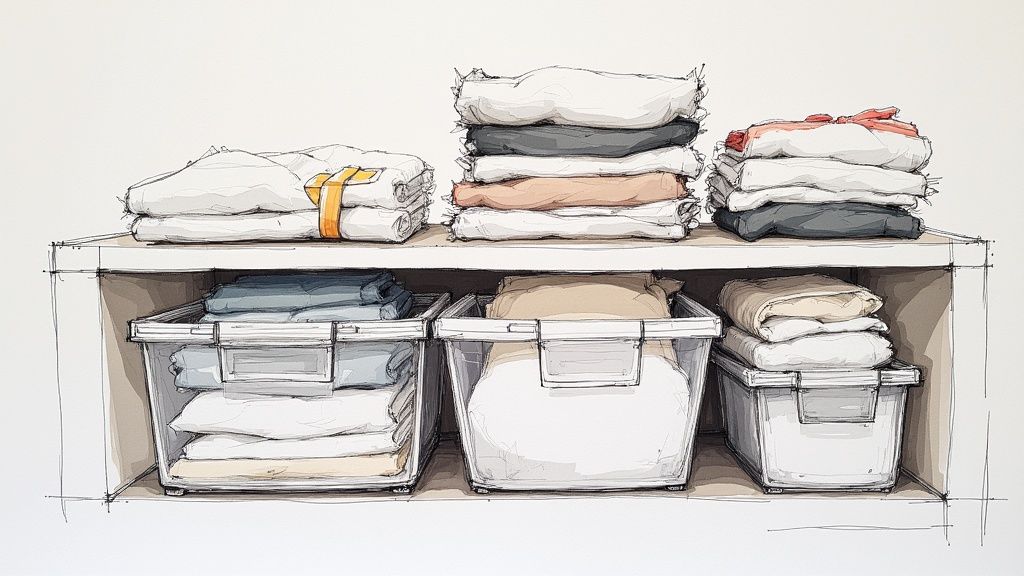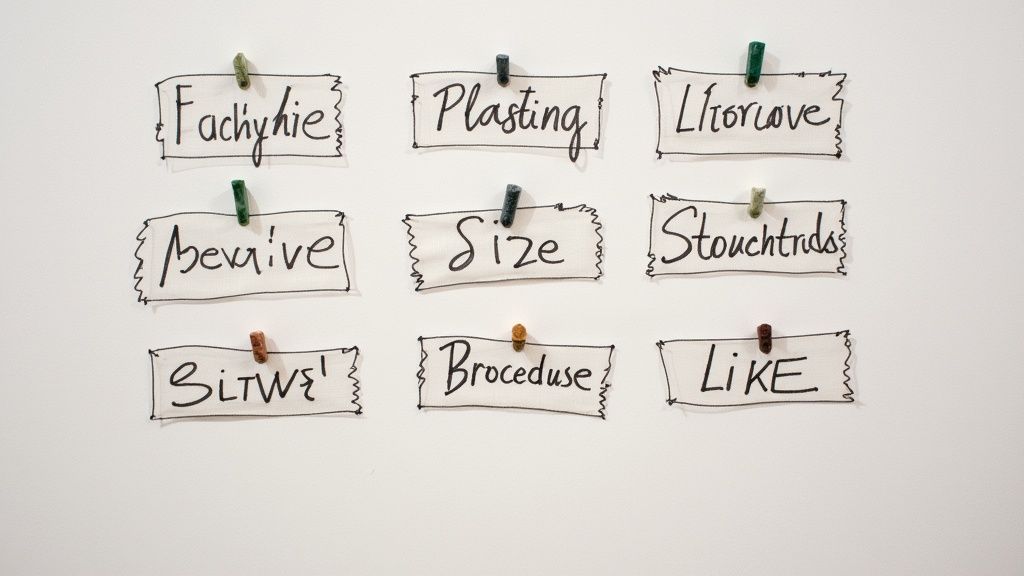Figuring out the best way to store baby clothes doesn't have to be complicated. After years of navigating mountains of tiny outfits, I've found a straightforward process that works wonders. It really boils down to four key actions: giving everything a final wash, sorting it all logically, using the right kind of containers, and finding a suitable spot to keep them.
Following these steps is crucial for keeping those delicate fabrics, especially all that soft cotton, in beautiful condition for another baby or even just for the memory box.
Your Quick Guide to Storing Baby Clothes
Properly storing your baby’s outgrown clothes is about more than just freeing up drawer space. It's a way of preserving precious memories and being practical for the future. From that first tiny cotton sleepsuit they wore home from the hospital to their favourite dribble-stained vest, every piece holds a story. Without a good system, you risk common problems like fabrics yellowing, developing musty smells, or even getting damaged by mildew.
This simple chart breaks down the thought process for every little cotton outfit you come across, helping you decide what to do with it.

Seeing the flow from gathering and sorting to the final decision can turn a seemingly endless task into something much more manageable.
To get you started, here’s a closer look at the core actions and why each one is so important for keeping those tiny cotton garments in perfect nick.
The Four Key Steps for Storing Baby Clothes
This table summarises the entire process. Think of it as your cheat sheet for making sure every cotton item is packed away perfectly, ready for its next adventure.
| Step | Action Required | Why It's Important |
|---|---|---|
| Clean | Wash and thoroughly dry every single garment. | This removes invisible stains like milk or drool, which are the main culprits behind yellow spots and mould growth on cotton over time. |
| Sort | Group everything by size and perhaps by season. | It makes life so much easier when you (or someone else) need to find specific items later on. No more rummaging! |
| Pack | Use breathable storage, like cotton bags or acid-free boxes. | Plastic containers trap moisture, leading to musty smells and potential damage to cotton fibres. Breathable options let the fabric relax. |
| Store | Find a cool, dark, and dry spot for the containers. | This protects clothes from temperature swings and sunlight, both of which can cause cotton colours to fade and fibres to weaken. |
By following this simple framework, you can be confident that every tiny piece of cotton clothing will be perfectly preserved.
If you're looking for even more ideas and detailed techniques, this guide on the best methods for storing baby clothes is a fantastic resource with lots of practical advice.
The Essential First Step: Washing Every Garment
Before you even think about folding or labelling, the absolute first thing on your list must be a thorough wash of every single item. I know it's tempting to pack away a cotton outfit that looks pristine after just one wear, but this step is non-negotiable for keeping clothes in great condition. It’s all about tackling the invisible culprits that can ruin delicate cotton.
The biggest offenders are proteins from milk, formula, and the inevitable spit-up. If you leave these on natural fibres like cotton, they’ll slowly oxidise in storage and create those stubborn yellow stains that are a nightmare to get out later. A final, comprehensive wash is your best defence.
Cotton is the workhorse of most baby wardrobes, loved for its softness, but it does need a bit of care to last. If you need a full walkthrough on dealing with daily grime and those tougher stains, you can explore our complete guide on how to wash baby clothes.
Choosing the Right Detergent and Drying Method
When you're washing cotton clothes for long-term storage, reach for a gentle, fragrance-free detergent. Your standard detergents and fabric softeners often contain perfumes and chemicals that leave a residue. Over months in a storage box, this residue can not only attract pests but also weaken the delicate cotton fibres.
My biggest tip: Make absolutely sure every item is 100% bone-dry before it gets packed away. Even the slightest hint of dampness, especially with the UK's often-damp climate, is an invitation for mould and mildew on cotton. You'll be met with a musty smell and potential ruin when you open that box again.
Think of this prep work as an investment. With the UK childrenswear market expected to hit around £7.85 billion by 2025, it’s no wonder so many of us are trying to make these clothes last longer. Getting the storage prep right for every little cotton bodysuit and sleepsuit is a smart move, both for your wallet and for the planet. You can read more about these trends in this detailed UK childrenswear market report.
A Smart System for Sorting and Organising

Now that your baby's cotton clothes are beautifully clean, you can set up an organisation system that your future self will thank you for. This is where you graduate from having a single, daunting pile of "outgrown" clothes and start thinking like a parent who’ll need to find something specific in a hurry. The aim here is to make grabbing exactly what you need effortless, whether that’s in six months or a few years.
The most liberating first step? A good declutter. Before you even think about sorting, decide what's genuinely worth keeping. I find it easiest to create three distinct piles: one for keepers, one for donations, and a small one for those extra-special cotton keepsakes.
If you’re struggling with this bit, our guide on embracing minimalist baby clothes has some fantastic advice on how to curate a more intentional and manageable wardrobe from the start.
Sub-Categorising for Future Sanity
Once you've got your 'keep' pile, don't just stop at sorting by size. Thinking ahead is the key to smart storage. Trust me, when you're rummaging for a 6-9 month winter sleepsuit, the last thing you want to be digging through is a pile of summer-weight cotton rompers.
This is why I always break down each size group into smaller, more logical sub-categories. It sounds like a bit of a faff, but it's a lifesaver later on.
- Sort by Season: Keep the warm-weather cotton vests and short-sleeved bodysuits separate from the cosy fleece sleepsuits and winter jumpers.
- Group by Type: Put similar items together. Think piles of leggings, stacks of long-sleeved cotton tops, or a section for special occasion outfits.
- Create a Keepsake Box: Pull aside those truly sentimental pieces—the coming home outfit, their first Christmas bib. These deserve their own special place.
This detailed approach really pays off, especially when you consider just how many clothes we end up with. The UK baby clothes market is forecast to generate around US$1.98bn in 2025 alone. That's an incredible number of tiny cotton garments that parents are buying and, eventually, needing to store.
Getting your space set up for success from the beginning makes all the difference. I’d recommend exploring a few effective closet organisation systems to get some inspiration. You can easily adapt professional strategies to fit your baby’s ever-growing collection.
Finally, label everything. And I mean everything. A simple stick-on label on the outside of each storage box that says something like, "6-9 Months, Winter, Sleepers & Vests" will completely eliminate any future guesswork. It’s a simple trick that makes all the difference.
Choosing Storage That Protects Your Clothes

After all that effort washing, folding, and labelling, the container you choose can either protect your hard work or completely undo it. It’s the final, crucial step. Get it right, and you'll open a box of fresh, ready-to-wear cotton outfits. Get it wrong, and you’re met with a musty, discoloured mess.
Your main goal here is to protect the fabric. For delicate natural fibres like cotton, this means picking containers that let the material breathe.
Why Breathable Containers Are Best
It’s easy to grab those standard plastic tubs, but for long-term storage of cotton, they’re often the worst thing you can use. Being airtight, they trap any tiny bit of moisture left in the clothes. This creates the perfect breeding ground for mildew and gives everything that unmistakable stale, locked-away smell. The lack of airflow can also cause cotton fabrics to yellow over time.
Instead, I always recommend storage solutions that encourage airflow:
- Canvas Bins: These are a great all-rounder. They’re sturdy, easy to stack, and let air circulate, which stops moisture from building up on cotton.
- Cotton Storage Bags: Using fabric to store fabric just makes sense. These bags are gentle on the clothes and are naturally breathable, perfect for cotton.
- Acid-Free Archival Boxes: If you have a few extra-special keepsake outfits—like a cotton christening gown or that first "coming home" outfit—these are worth the investment. They're what museums use and are designed to preserve textiles for decades.
Storage Methods and Locations to Avoid
Some space-saving tricks are tempting, but they can cause real damage to soft cotton clothes.
A word of caution on vacuum-sealed bags: They’re brilliant for reclaiming wardrobe space, I get it. But the intense compression can crush and break down natural cotton fibres. You'll be left with deep-set wrinkles that never quite come out, and the fabric can lose its signature softness for good.
Just as important is where you put the containers. The ideal spot is cool, dark, and dry. Think of a high shelf in a bedroom wardrobe or neatly tucked under a bed in a climate-controlled part of your house.
There are a few places I’d strongly suggest you avoid:
- Attics and Lofts: These spots suffer from extreme temperature swings, from roasting hot in the summer to freezing in the winter. This constant change weakens cotton fibres over time.
- Garages and Sheds: These areas are often damp and are prime real estate for pests. Definitely not a safe home for treasured cotton textiles.
- Basements: Unless your basement is fully finished and climate-controlled, the natural dampness is a major risk for mould and mildew.
Choosing the right containers and a stable storage spot sets those cotton clothes up for a long and useful life. It's always a good idea to brush up on the basics of stowing belongings safely in packing boxes to make sure you're maximising your space without putting those precious garments at risk.
Right, so you've packed everything away. Job done? Not quite. Keeping those tiny cotton clothes in pristine condition while they're in storage requires a little bit of attention now and then. Think of it as a quick check-in to make sure your future hand-me-downs are still perfect.
I’ve found that popping in to check on my storage bins every 6-12 months is a simple but really effective habit. It only takes a few minutes, but it's your best defence against any sneaky problems like dampness, mildew, or pests before they have a chance to ruin all your hard work.
Keeping Moths and Musty Smells at Bay
When you think of protecting stored clothes, old-fashioned mothballs might come to mind. My advice? Steer clear. The chemical smell is incredibly strong, a nightmare to get out of fabrics, and you definitely don't want those residues anywhere near a baby’s delicate skin.
Thankfully, natural alternatives work brilliantly and are so much safer for cotton.
- Cedar Blocks or Balls: These are my go-to. Cedar has a lovely, fresh scent and it's a fantastic natural deterrent for moths and other little critters.
- Dried Lavender Sachets: A few of these tucked into the corners of a storage box will stop that tell-tale stale smell from ever developing in your stored cottons.
The goal is simple: when you open that box in a year or two, you want the cotton clothes inside to smell fresh, not like they've been hibernating. Natural repellents get you there without any harsh chemicals.
Finally, when the time comes to unpack those treasures for your next baby or to pass them on, let them breathe first. A good airing out for a day, followed by a gentle wash, will have them feeling soft, smelling fresh, and ready for their next adventure.
Got Questions About Storing Baby Clothes? We’ve Got Answers.
Even with the best intentions and a solid plan, a few questions always seem to pop up when you’re packing away those tiny cotton outfits. It’s completely normal to second-guess yourself, especially when you’re dealing with clothes full of precious memories. We hear these queries all the time from parents, so let’s clear them up.
Getting these little details right is what gives you peace of mind, knowing those cotton clothes will be just as sweet when you pull them out as they were when you packed them away.
How Long Can Cotton Baby Clothes Really Be Stored?
Honestly, if they’re stored properly, high-quality cotton baby clothes can be kept beautifully for years and years. We’re talking long enough for the next baby to come along, or even for the next generation. The real trick isn't about a specific timeline; it's all about the environment you keep them in.
The things that will ruin your carefully stored cotton items are moisture, big temperature swings, and light. If you use breathable containers (like canvas bins) and tuck them away somewhere with a stable, controlled climate—think the top of a wardrobe, not the loft—you’re setting them up for success. I always recommend a quick check every 6-12 months just to make sure everything is still fresh and dry.
Is It Better to Fold or Hang Baby Clothes for Storage?
For anything long-term, folding is definitely the way to go, especially for cotton. Hanging tiny outfits for months or years puts constant stress on the fabric, particularly around the delicate shoulders and necklines of little cotton bodysuits and tops. You’ll often find they get stretched out and lose their shape completely.
Folding items neatly avoids this problem. For an even better, space-saving trick that also helps prevent hard creases, try rolling softer things like cotton sleepsuits, leggings, and vests before you pop them into your storage bins.
What About Using Vacuum Bags? They Save So Much Space!
I know it's incredibly tempting to use vacuum-sealed bags, but please, step away from the vacuum! For natural fibres like cotton, they can do more harm than good.
That intense compression actually crushes the delicate cotton fibres. This can lead to deep-set, permanent wrinkles that no amount of ironing will fix. Worse still, it can damage the very structure of the fibres, so the fabric won't feel as soft or breathable when you finally unpack it. You risk ruining the lovely cotton items you're trying so hard to protect.
Can I Just Stick Everything in the Attic or Loft?
While it might seem like the perfect out-of-the-way spot, the attic or loft is probably one of the worst places you could choose for storing clothes, especially cotton. These spaces go through wild temperature changes—roasting in the summer and freezing in the winter.
This constant cycle of hot and cold makes cotton fibres expand and contract, which weakens them over time and makes them brittle. Your best bet is always a stable, indoor location where the temperature doesn’t act like a rollercoaster.
At Little Novice, we’re passionate about creating clothes that are truly designed to last, ready to be passed down and loved all over again. Our timeless, sustainable cotton pieces are the perfect start for a wardrobe built on quality and care. Discover our collection today.